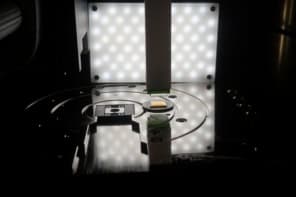Researchers in Germany and the US have made a breakthrough in understanding colossal resistance – the dramatic drop in electrical resistance that occurs when some solids are placed in an electric or magnetic field. They found that the effect is due to quasiparticles called “polarons” transforming from a solid to a liquid. A better understanding of colossal resistance could lead to the effect being used to improve sensors that detect magnetic fields or boost the density of computer memories (PNAS 104 13597 ).
Nearly 15 years ago, two groups working independently discovered that the electrical resistance of manganese oxides called manganites dropped by several orders of magnitude when the materials were exposed to a magnetic field. Dubbed colossal magnetoresistance (CMR), the effect is much different than giant magnetoresistance, which is relatively well understood and involves changes in resistance of several tens of percent. However, very little progress has been made in understanding CMR and the related effect of colossal electroresistance (CER), which occurs when some manganites are exposed to external electric fields.
Physicists had suspected that CMR and CER are related to polarons, which are charged quasiparticles that arise when conduction electrons and vibrating atoms (phonons) in a solid interact. In the absence of an external electric or magnetic field, electron-phonon interactions are thought to be strong enough to localize the polarons in an ordered “solid” that gives the material a high resistance.
However, an applied field is thought to weaken the electron-phonon interaction, allowing the polarons to move around much like a liquid. In some cases, the polarons strongly delocalize and move so freely that resemble the conduction electrons in a metal, explaining the 1010 drop in resistance seen in some manganites.
Now, a team including Christian Jooss at the University of Goettingen in Germany and Yimei Zhu from the Brookhaven National Laboratory in the US has confirmed the role of polaron “melting” in colossal resistance by watching the resistance of a manganite sample drop as its polarons transformed from solid to liquid.
The team used the tip of a scanning tunnelling microscope (STM) to apply an electric field to a small region of the sample and also to measure the resistance in that region. The tip was brought into contact with the sample and several volts was applied to create an electric field. The resistance of the sample could be determined by measuring the current flowing between the tip and the sample. At the same time a transmission electron microscope (TEM) was used to perform electron-diffraction measurements which confirmed that solid polarons in that region turned to liquid when a sufficiently large field was applied.
Although their experiments focussed on CER, the team are confident that their findings with help further the understanding of CMR as well. The researchers also believe that their work could make it possible for CER to be used to create resistive -random access memory (RRAM) devices, which are currently being developed by several chip makers. In a RRAM, data are stored in bits that can be switched between a very high resistance state and a very low resistance state. This simplifies the circuit design, shrinking the size of individual memory bits and allowing the data to be read and written hundreds of times faster than conventional memories.



